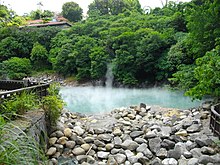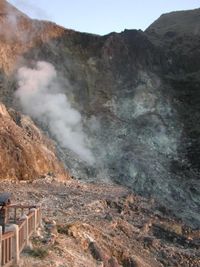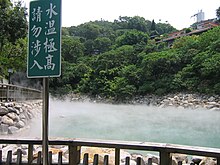
Sodium hydroxide, also known as lye and caustic soda, is an inorganic compound with the formula NaOH. It is a white solid ionic compound consisting of sodium cations Na+ and hydroxide anions OH−.

A hot spring, hydrothermal spring, or geothermal spring is a spring produced by the emergence of geothermally heated groundwater onto the surface of the Earth. The groundwater is heated either by shallow bodies of magma or by circulation through faults to hot rock deep in the Earth's crust.
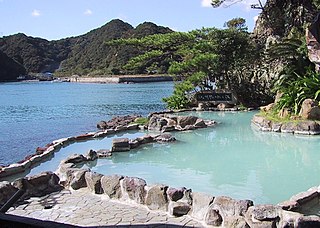
In Japan, onsen are hot springs and the bathing facilities and traditional inns around them. There are approximately 25,000 hot spring sources throughout Japan, and approximately 3,000 onsen establishments use naturally hot water from these geothermally heated springs.

Yangmingshan National Park is one of the nine national parks in Taiwan, located in both Taipei and New Taipei City. The districts that are partially in the park include Taipei's Beitou and Shilin Districts; and New Taipei's Wanli, Jinshan, Sanzhi and Tamsui Districts. The national park is known for its cherry blossoms, hot springs, sulfur deposits, fumaroles, venomous snakes, and hiking trails, including Taiwan's tallest dormant volcano, Qixing Mountain rising to 1,120 m (3,675 ft).

Beitou District is the northernmost of the twelve districts of Taipei City, Taiwan. The historical spelling of the district is Peitou. The name originates from the Ketagalan word Kipatauw, meaning witch. Beitou is the most mountainous and highest of Taipei's districts, encompassing a meadow with rivers running through the valley which have abundant steam rising from them; the result of geothermal warming. The valley is often surrounded by mist shrouding the trees and grass. Beitou is famous for its hot springs. In March 2012, it was named one of the Top 10 Small Tourist Towns by the Tourism Bureau of Taiwan.

Mineral springs are naturally occurring springs that produce hard water, water that contains dissolved minerals. Salts, sulfur compounds, and gases are among the substances that can be dissolved in the spring water during its passage underground. In this they are unlike sweet springs, which produce soft water with no noticeable dissolved gasses. The dissolved minerals may alter the water's taste. Mineral water obtained from mineral springs, and the precipitated salts such as Epsom salt have long been important commercial products.
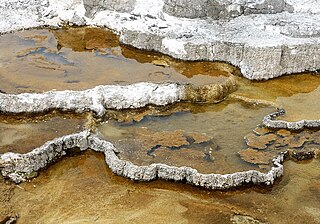
Sulfur water is a condition where water is exposed to hydrogen sulfide gas, giving it a distinct "rotten egg" smell. This condition has different purposes in culture varying from health to implications for plumbing.

Yangmingshan Administrative Bureau was a county level administrative body in Republic of China's Taiwan Province between 1949 and 1973.

Mount Hachimantai is the highest peak of a group of stratovolcanos distributed around the Hachimantai plateau in the Ōu Mountains in northern Honshū, Japan. This volcanic plateau is part of the Nasu Volcanic Zone and straddles the border between the Iwate Prefecture and Akita Prefecture. The volcano is listed as one of the 100 Famous Japanese Mountains, and forms part of the Towada-Hachimantai National Park.

The island of Taiwan was formed approximately 4 to 5 million years ago at a convergent boundary between the Philippine Sea Plate and the Eurasian Plate. In a boundary running the length of the island and continuing southwards, the Eurasian Plate is sliding under the Philippine Sea Plate. In the northeast of the island, the Philippine Sea Plate slides under the Eurasian Plate. Most of the island comprises a huge fault block tilted to the west.

Beppu Onsen (別府温泉) is an extensive hot spring system in the city of Beppu, Ōita, Japan. There are eight distinct major thermal spring zones called "Beppu Hatto"(別府八湯).
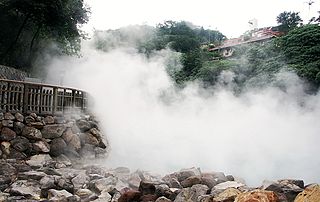
The Thermal Valley is a valley located on the foothill of Yangmingshan National Park in Beitou District, Taipei, Taiwan. This makes Thermal Valley one of the sources of acidic sulfur hot spring in the area. Locals also sometimes refer to it as Hell Valley. The formula of this mineral water contains Plaster, Alunite, Jarosite, Realgar, Sulfur, and Radium. pH value is between 1.4~1.6, the highest temperature could be reached to 90 Celsius. It was one of the eight attractions and twelve scenic spots in Taiwan during the Japanese colonial period.

The Taiwan Exposition: In Commemoration of the First Forty Years of Colonial Rule was an exhibition held in Taihoku Prefecture in 1935, the 10th year of Hirohito's reign, to mark 40 years of the establishment of Japanese Formosa.
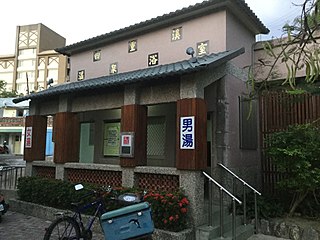
The Sichongxi Hot Spring is a hot spring in Checheng Township, Pingtung County, Taiwan.

Unazuki Onsen is a hot spring resort located in the city of Kurobe, Toyama Prefecture, Japan, at the entrance of the Kurobe Gorge.
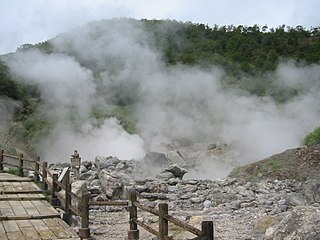
Unzen Onsen is a geothermally heated volcanic hot spring field in the Unzen Mountains in Nagasaki prefecture in Japan. It was known of for many years, and in the 1910s was developed into a hot spring community because of its many springs. In 1934 the area was designated as the first national park in Japan.
Hakone Onsen, or Hakone Hot Springs, is a general term for numerous thermal spas located in the town of Hakone, Ashigarashimo District, Kanagawa Prefecture, Japan, an area formerly known as Sagami Province. Situated about 90 kilometres (56 mi) southwest of Tokyo and 60 kilometres (37 mi) east-southeast of Mt. Fuji, it is one of the most popular hot spring resorts in central Japan. At least twenty hot spring spring resorts exist around Mt. Hakone, an area that is designated as part of the Fuji Hakone Izu National Park.

Yunomine Onsen is a hot spring system and resort town in Tanabe, near Hongu Town in southern Wakayama Prefecture, Japan. The Tsuboyu bath is located there, a UNESCO World Heritage site.
